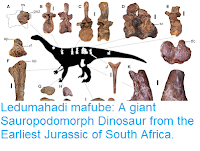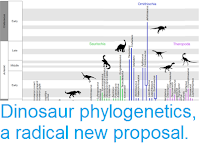Sauropod Dinosaurs are the largest known land animals ever to have walked the Earth, with some species reaching masses of around 60 tonnes, larger than any member of any other Dinosaur group, and exceeded only by the modern Baleen Whales (which are fully marine in nature). These Dinosaurs descended from the Prosauropods, a polyphyletic group (i.e. a group which does not include all the descendants of their most recent common ancestor, since Sauropods are not considered to be Prosauropods; polyphyletic groups are not considered valid by many modern taxonomists) which includes early bipedal forms, and which may have split of from other Dinosaur groups before the Ornithischia/Saurischia split, with the two groups being together known as the Sauropodomorphs.
The earliest known Sauropodomorphs are relatively small-bodied forms from early Late Triassic (about 233 million years old) in Brazil, suggesting that the group originated in this area, though these forms lack many of the key features associated with the group, such as elongate necks and slender skulls.
In a paper published in the journal Biology Letters on 21 November 2018, Rodrigo Temp Müller of the Programa de Pós Graduaçaõ em Biodiversidade Animal and the Centro de Apoio à Pesquisa Paleontológica da Quarta Colônia at the Universidade Federal de Santa Maria, Max Cardoso Langer of the Laboratório de Paleontologia at the Universidade de São Paulo, and Sérgio Dias-da-Silva, also of the Centro de Apoio à Pesquisa Paleontológica da Quarta Colônia at the Universidade Federal de Santa Maria, describe a new species of Sauropodomorph Dinosaur from the Late Triassic of Rio Grande do Sul State, Brazil.
The new species is named Macrocollum itaquii, where ‘Macrocollum’ means ‘long-neck’ and ‘itaquii’ honours José Jerundino Machado Itaqui, for his role in the formation of the Centro de Apoio à Pesquisa Paleontológica da Quarta Colônia. The species is described from three specimens, two almost complete and one lacking the skull and cervical vertebrae (neck). The specimens clearly show the elongate neck and slender skull of later Sauropodomorphs, and is dated to about 225 million years ago, coming from the upper portion of the Candelária Sequence of the Paraná Basin, making this species only about eight million years younger that the oldest known Sauropodomorphs. Müller et al. also suggest that the fact that three specimens were found together may be indicative that Macrocollum itaquii had began to develop social behaviour.
In a paper published in the journal Biology Letters on 21 November 2018, Rodrigo Temp Müller of the Programa de Pós Graduaçaõ em Biodiversidade Animal and the Centro de Apoio à Pesquisa Paleontológica da Quarta Colônia at the Universidade Federal de Santa Maria, Max Cardoso Langer of the Laboratório de Paleontologia at the Universidade de São Paulo, and Sérgio Dias-da-Silva, also of the Centro de Apoio à Pesquisa Paleontológica da Quarta Colônia at the Universidade Federal de Santa Maria, describe a new species of Sauropodomorph Dinosaur from the Late Triassic of Rio Grande do Sul State, Brazil.
The new species is named Macrocollum itaquii, where ‘Macrocollum’ means ‘long-neck’ and ‘itaquii’ honours José Jerundino Machado Itaqui, for his role in the formation of the Centro de Apoio à Pesquisa Paleontológica da Quarta Colônia. The species is described from three specimens, two almost complete and one lacking the skull and cervical vertebrae (neck). The specimens clearly show the elongate neck and slender skull of later Sauropodomorphs, and is dated to about 225 million years ago, coming from the upper portion of the Candelária Sequence of the Paraná Basin, making this species only about eight million years younger that the oldest known Sauropodomorphs. Müller et al. also suggest that the fact that three specimens were found together may be indicative that Macrocollum itaquii had began to develop social behaviour.
Reconstructed skeleton and representative elements of Macrocollum itaquii. (a) Skull in left lateral view. (b) Skull in dorsal view. (c) Skull in ventral view. (d) Fourth cervical vertebra in left lateral view. (e) Mid-truncal vertebra in left lateral view. (f) Left ilium in lateral view. (g) Left ischium in lateral view. (h) Right pectoral girdle in lateral view. (i) Right manual digit I in medial view. (j) Right astragalus in dorsal view. (k) Right femur in cranial view. (l) Left pes in cranial view. Abbreviations: I-1, phalanx one of the digit I; I-2, phalanx two of the digit I; a, angular; ap, ascending process; co, coracoid; crt, crest; ct, cranial trochanter; d, dentary; dp, diapophysis; epi, epipophysis; f, frontral; fh, femoral head; fob, fossa for the olfactoy bulbus; inf, internarial fenestra; is, ischium shaft; j, jugal; mc, medial condyle; mcI, metacarpal I; mtI, metatarsal I; mtIII, metatarsal III; mtV, metatarsal V; mw, medial wall; mx, maxilla; n, nasal; ns, neural spine; opl, obturador plate; p, parietal; pa, parapophysis; paa, postacetabular ala; pmfo, promaxillary fenestra; pmx, premaxilla; po, postorbital; poz, postzygapophysis; prf, prefrontal; prz, prezygapophysis; q, quadrate; qj, quadratojugal; sa, surangular; sac, supracetabular crest; scp, scapula; sq, squamosal; stf, supratemporal fenestra. Scale bar is 50 mm. Müller et al. (2018).
See also...
Follow Sciency Thoughts on Facebook.







